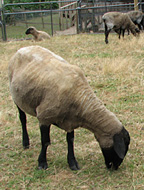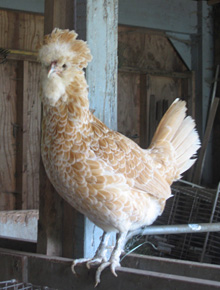Farm Animal FAQs
I. What Does It Cost?
The BaaHaus grocery bill runs on average over $1200 a month. Here are some specifics on our weekly feed consumption and pricing:Dry COB (Corn Oats Barley mixture) 550lbs = $176.00
Sheep feed 600 lbs = $240.00
Cracked Corn 600 lbs = $170.00
Organic Chicken scratch 200 lbs = $162.00
Rabbit pellets 250 lbs = $100.00
Minipig pellets 100 lbs = $140.00
Goat feed 300 lbs = $132.00
Orchard Grass Hay 12 3-strand bales = $312.00
Senior Donkey Feed 150 lbs = $174.00
Llama Feed 200 lbs = $148.00
All the animals get extra goodies, too, from fresh fruit and vegetables to very high quality whole grain breads, thanks to donations from Sandy's grocery store in Burton, the Episcopal Church of the Holy Spirit, Essential Bakery, and the gardens of our friends and neighbors.
II. One Pleasant Fact
Become a vegetarian and save the lives of approximately 100 animals a year.III. A few Definitions
What does "free range" mean?Legally, it means almost nothing. It could mean that the hen has a few extra square inches of space in her cage, or that the door of the chicken shed is opened for five minutes or an hour a day, or that she can see out of a window (or at least there IS a window in the shed holding tens of thousands of chickens).
What does "free range eggs" mean?
Nothing. It's just a marketing label. It does not even mean that the egg came from a "free range" hen, which as we have learned above, means almost nothing.
What does "raised naturally" really mean?
Nothing. The power of the phrase creates a mental picture in the minds of consumers that what they are about to eat had a lovely (if brief) life.
IV. Lifespan of Farm Animals
 One quandary we faced when starting BaaHaus was trying to determine
average life expectancies of domesticated animals. Back in the 1980's, all the books on so-called modern animal husbandry concluded with a chapter on butchery which, for most animals came before the animal was even a year old, so no one knew or cared how long a farm animal could live. We have learned that farm animals can have relatively long, comfortable lives, similar to those of dogs, cats, horses and the family canary.
One quandary we faced when starting BaaHaus was trying to determine
average life expectancies of domesticated animals. Back in the 1980's, all the books on so-called modern animal husbandry concluded with a chapter on butchery which, for most animals came before the animal was even a year old, so no one knew or cared how long a farm animal could live. We have learned that farm animals can have relatively long, comfortable lives, similar to those of dogs, cats, horses and the family canary.
Average age of factory farmed animals at time of slaughter:
Beef cattle:
10 to 18 months; cattle can easily live into their early- to mid-twenties if not afflicted with eye cancerChickens:
6 to 8 weeks; Zsa Zsa, the fabulous Golden Polish hen, lived at BaaHaus for over 10 years--not an unusual chicken lifespan. Big Daddy lived to be at least 12 and was probably closer to 14.Dairy cows:
impregnated at around 15 months and kept constantly pregnant for another 4 years, the dairy cow is slaughtered for meat as soon as her milk production begins to decrease. Here is the forgotten victim of commercial food production. Consumers don't buy anything packaged and identified as "dairy cow meat" although exhausted dairy cow bodies make up nearly 20% of the beef sold in the U.S. So while these bovines live two or three years longer than beef cattle, their lives are far more wretched. Hooked to a electric milking machine three times a day for seven days a week ten months of the year--yes, pregnant during seven of those ten months--, living in crowded feed lots and prone to many diseases, the 4 or 5 year old dairy cow is then culled when milk production drops and/or she is physically incapacitated by the many diseases which flourish in this population. If allowed to live normally, she would enjoy 15 to 25 years, similar to that of a steer.Lambs:
usually 3 to 5 months, rarely more than 24 months. The rare lamb who grows up to become a sheep can live happily for 6 to 11 years, or even longer. Wally, one of the first animals to come to BaaHaus, is now 12. Suzzy, an unwanted 4-H project, is 13 or 14.Pigs:
6 to 7 months; normal life expectancy of a well cared for hog is between 8 and 10 years, or even longer. Potbelly pigs can live well into their teens. Annie was 18 at the time of her death.Turkeys:
4 to 5 months; our experience with turkeys is very limited, but there are virtually no "normal" domestic turkeys left except for some of the wild strains who are being brought back by turkey enthusiasts. The monstrously over-engineered, genetically altered commercial turkey carcass found at the grocery store, bred for such over-sized breasts that the living bird can scarcely walk, simply could not have survived for more than a few years if he had evaded slaughter. Our rescued tom turkey Rusty lived for only about 3 years.Veal Calves:
Really, are we still debating this cruel practice? Veal comes from male calves who are taken from their mothers within hours of birth. Confined to small crates, deprived of all normal sensory sensations, fed an iron-deficient formula diet (to keep the muscle tissue white), it is no surprise that up to 20% of these poor creatures die before the average slaughtering age of 16 weeks. But then, death must come as a relief to these animals.
V. Health Concerns
 Factory farming is unhealthy for the animal and the human consumer. Read the paper and listen to the news for the constant warnings about recalled hamburger, eggs, sausage, meat-filled fast food salads, and fresh
vegetables which have been tainted by fertilizers, dirty processing plants and containers, unsanitary kitchen workers, and other vectors.
We believe for moral and ethical reasons that animals should not be eaten. But if serious health scares will turn you into a vegetarian, we say "Whatever it takes." Just keep listening to the news.
Factory farming is unhealthy for the animal and the human consumer. Read the paper and listen to the news for the constant warnings about recalled hamburger, eggs, sausage, meat-filled fast food salads, and fresh
vegetables which have been tainted by fertilizers, dirty processing plants and containers, unsanitary kitchen workers, and other vectors.
We believe for moral and ethical reasons that animals should not be eaten. But if serious health scares will turn you into a vegetarian, we say "Whatever it takes." Just keep listening to the news.
VI. Recommended Reading
Many books have been published recently which decry the treatment of farm animals and describe the benefits of a vegetarian or vegan diet. Here are just a few:An American Trilogy; Death, Slavery, & Dominion on the Banks of the Cape Fear River, by Steven M. WIse. Philadelphia: Da Capo Press, 2009. Taking an interesting perspective on American history and pork, Wise investigates the history of a particular plot of North Carolina land, once the forest preserve of American Indians, then a slave plantation and now one of the largest hog slaughter operations in the U.S.
Dominion; the Power of Man, the Suffering of Animals, and the Call to Mercy, by Matthew Scully. New York: St. Martin's Press, 2002. A conservative former speech writer for George W. Bush (yes, you read that right), Matthew Scully has written one of the most articulate and compelling books on the moral and ethical responsibilities humans must consider in their treatment of animals.
Eating Animals, by Jonathan Safran Foer. New York: Little, Brown & Company, 2009. By one of the best novelists of our time (Everything is Illuminated and Extremely Loud and Incredibly Close), Foer comes from a food-centric family--particularly his grandmother's cooking. But the birth of his first child got him thinking about just what is in the modern meat we eat. In this scrupulously researched and highly readable work, Foer lays out the facts about our food industry, and lets his emotions speak for the animals.
Farm Sanctuary, by Gene Baur. New York: Simon & Schuster, 2008. Baur is a leading animal rights activist and the founder of Farm Sanctuary, one of the largest farm animal rescue organizations in the U.S. His book is a well reasoned and calmly argued consideration of the true cost of factory farming to both the animals and the workers who live and die inside the animal food industry.
For the Love of Animals; the Rise of the Animal Protection Movement, by Kathryn Shevelow. New York: Henry Holt & Company, 2008. Shevelow's book is a well researched and fascinating social and legal history of the animal welfare movement, begun in Great Britain in the 18th century.
The Good Good Pig; the Extraordinary Life of Christopher Hogwood, by Sy Montgomery. New York: Ballentine Books, 2006. Give yourself a break and discover the joys of really getting to know a hog. Pigs are among the most intelligent and sensitive beings on the planet, and yet they are raised and slaughtered in perhaps the most brutal industrial manner. This book is about a very well treated porcine. Christopher's life story is a much needed antidote to the rest of the information on this page.
